
How the Evergreen Mountain Bike Alliance Started A Revolution
Blood Sweat and Gears: The I-90 Corridor
Story by Max RitterLike so many riders around here, I got my first true taste of PNW riding at Duthie Hill Mountain Bike Park on a gloomy day where the sky wasn’t quite sure whether it would start pouring rain. That first experience, on Thanksgiving Day in 2017, with lap after lap of grin-inducing riding on the nearly two-dozen XC and freeride trails, kickstarted a love affair with loam that I’ve been unable to shake. Thanks to many trips back to the area since, that love affair has been compounded after getting to know the nooks and crannies of the hundreds of miles of singletrack in the greater Seattle area. That singletrack is spread over nearly a dozen different riding areas, most of which would be world-class destinations on their own, all within a 30-minute drive of the city. It’s clear that this might be one of the best places in the world to be a mountain biker. This past spring, I dove deep into the story behind trail building and access in this part of the country, learning about how the Evergreen Mountain Bike Alliance has worked tirelessly for the past decade to ensure a bright future for bikes.
There’s really no better place to start this story than in the woods of a Seattle suburb. Actually, let’s back up a few years to 2005, when the City of Seattle was unsure of what to do about a neglected plot of land beneath the I-5 overpass at Collonade Park. What had essentially turned into an unsanctioned trash heap was the start of something special for PNW mountain biking as it’s known today. Years of hard work by local mountain bike advocates including Art Tuftee, Justin Vander Pol and Brian Jones finally paid off when the Backcountry Bicycle Trails Club (the organization Evergreen eventually grew out of) was awarded its first professional trail building contract to turn Collonade Park into the first urban bike park in the country. The project, which broke ground on October 14, 2005 and finally finished in 2008, proved to outdoor industry stakeholders and local authorities that cyclists in Seattle were serious about supporting new trail construction through volunteer work and a dedication to doing things right. As the Collonade project was drawing to a close, plans were already being hatched for a bigger and better version of a bike park to be built in the Seattle suburbs – the birth of Duthie Hill.

Trevor Ford lining up a big one deep in the Washington woods. | Max Ritter photo.
Duthie Hill Mountain Bike Park
So what’s Duthie all about? The best way to answer that question is to just go ride there. Since that first time in the fall of 2017, I’ve been lucky enough to return to Duthie a few times, but this past May I finally got the local’s tour, meeting up with a crew of riders and trailbuilders from Evergreen to learn the story behind these trails. Set up in a four-leaf clover shape, the bike park is centered around a clearing that makes for an easy spot to meet up with friends and proves that the park is designed first and foremost around building community. One rainy morning, I decided to meet up with Evergreen trailbuilder Sean Sweeney and his team of volunteers at the park.
Wet weather makes for great dirt for building, so the crew was already very busy when I got there. “Meet us over on Semper D,” read a text from Sweeney, and I hurried over to the immaculately-shaped double-black jump trail named Semper Dirticus that’s tucked into the woods in the park’s “flow zone.” Made up of a series of medium-to-large sized dirt jumps, a few wooden features, and massive berms, this local’s favorite was in the middle of getting a much-needed refresh. Looking around, nearly every feature either looked brand-new, or had a team of volunteers digging and re-shaping lips and landings. Sweeney introduced me to the crew, made up of riders of all ages and ability levels (high school kids digging on their days off of school was a cool sight to see). “Even though we often have pros doing the work, we can’t lose sight that we’re a community trail building organization. We have so many volunteers who want to get their hands dirty, and it’s days like this that make that happen,” said Sweeney.
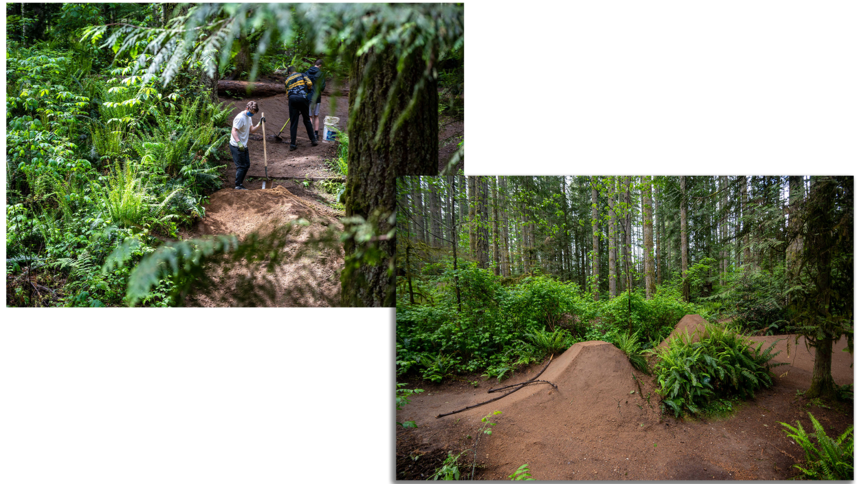
Duthie Hill, and for that matter every trail in the greater Seattle area, is built by the community, for the community. | Max Ritter photos.
Many of the Duthie trails were built as part of the original buildout between 2009 and 2012, built with much smaller bikes in mind. Keep in mind, the majority of riders ten years ago were rocking 26-inch wheels – and hitting jumps meant you were probably riding a dedicated dirt jumper or a slopestyle bike. Now, with the advent of long and slack 29ers, the trails felt a little cramped for most riders, so Evergreen took that into account when it came to revamping trails. That’s not to say the jumps are being “sanitized” and made too mellow for expert riders to have fun on – these are still jump lines that require some serious technical skill. The good news? All of Duthie’s trails are built with progression in mind. Starting on something smaller, like nearby Voodoo Child or my personal favorite, Gravy Train, is a great way to get a feel for airtime and progress your jumping skills. If working on corners or speed is more what you are looking for, give Deuces Wild (a dual slalom course) or Ryan’s Line a whirl. Once you’re feeling comfortable in the air is when Duthie really starts to get fun, with a variety of true double-black freeride lines scattered throughout the park like HLC, Flying Squirrel, Semper Dirticus, Double Trouble, Big Tree, Paramount, and 12-Step.
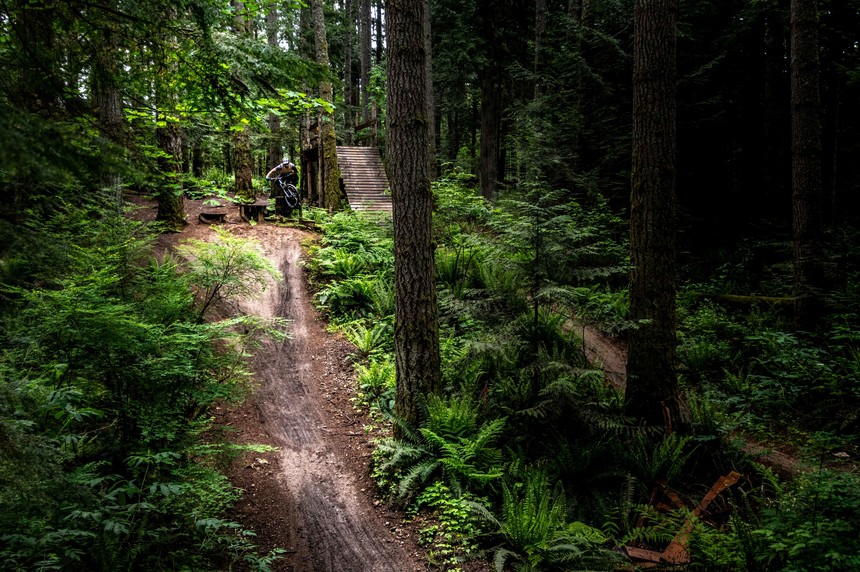
Duthie is the ultimate spot for a progression session, as demonstrated here by Trevor Ford. | Max Ritter photo.
Sweeney tells me a little more about the philosophy Evergreen has developed over the years, something they have called “agile trail building.” This, of course, isn’t limited to Duthie, but happens everywhere Evergreen is carving in singletrack, including the new trails in the greater Seattle area in zones like Raging River and Tiger Mountain. There’s a lot of experimentation that happens before a trail is fully opened to the public. “Cut it, ride it, close it, re-think, re-build, re-ride. Open,” Sweeney says. Like at Duthie, much of the work is done by volunteer trail crews using a tried-and-true process. First, objectives are set for the trail and a lead builder (often a volunteer) gets to go for a walk in the woods to flag it, before getting approval from Evergreen and a local land manager to make sure it’s sustainable in the long term. Next, a dig crew goes out and builds the initial routing of the trail. Then the lead builder gets to assign target riders that can test the trail to identify where things need to be changed (like re-shaping jumps, re-routing corners, or reinforcing any high-erosion areas) before the dig crew puts on the final touches. Finally, the trails are opened to the public. It’s easy to see this process in action at a relatively small trail zone like Duthie, but seeing it done on much larger and spread-out networks around the state is truly amazing.
Tiger Mountain
It’s not just all about Duthie Hill in the Seattle area. In fact, while the bike park might be Evergreen’s first real foray into building trail networks in the woods, it’s just a tiny fraction of what’s available for riders around the area. Just a few miles away, Issaquah’s Tiger Mountain is the next destination on my list. Distinctly different from Duthie, Tiger features some of the best technical downhill riding I have ridden, and unsurprisingly another part of Evergreen’s story. To learn a little more about its development, I chatted with Evergreen’s Executive Director Yvonne Kraus who paints the picture of how far the organization has come since she started riding in Washington in 1997.
“Tiger was seasonal at first, we would ride the road up then ride down Preston, NW Timber, and Iverson. That’s all we had. To see how the corridor has progressed since then is amazing. We’ve got 40 miles of trail between Raging and Tiger, Grand Ridge, Duthie, Olallie, and that’s just within a few square miles,” she says. King County, and the greater Seattle area is an incredibly densely populated area, home to over 4 million people, who all have access to nearly a dozen mountain bike trailheads within a short drive from home. Of course, working with land managers, particularly in such a populous county, comes with its own challenges. But, as Kraus explains, Evergreen's relentless advocacy back in the 2000's and prior to make the case for state investment in mountain bike trails paved the way for constructive collaboration between trailbuilders, users, and authorities like the Washington Department of Natural Resources (DNR), the Forest Service, and even private landowners. It’s clear that mountain biking is part of the culture here, and not just relegated to the fringes like it is in so many communities around the country. In fact, much of the trail building is actually paid for and supported with state money through official recreation and conservation channels set up expressly with that purpose in mind. Trailbuilding is expensive, costing anywhere from $10,000 to $100,000 per mile, depending on the type of soil and how much water must be managed, so tapping into generous state budgets goes a long way.

A common sight around Washington's mountains are fresh clear cuts by commercial logging operations. Out of the ashes arises new life for fresh trails. | Lily Krass photo.
“Washington State's amazingly effective Recreation and Conservation Office, which serves as the backbone for recreation funding through competitive grants, began issuing funds for dedicated mountain bike trail networks via grant applications,” says Kraus, sharing that the close collaboration between Evergreen and land managers is something neither agency takes for granted. That ongoing partnership, particularly between Evergreen and DNR to meet the needs of the fast-growing mountain bike community within the corridor, allowed the trailbuilders to create innovative new trail plans and lead the public agency in accepting directional trails, tracked loops, and double black diamond trails, and create a set of standards and signage to support them. In other words, thanks to a solid foundation laid by the early members of Evergreen, the government and land managers more or less let the mountain bikers run their own show when it comes to building world-class trails on public lands.
Tiger Mountain is yet another prime example of that. Home to the first legitimately-built double-black downhill trail in Washington, Predator, the trail network off I-90’s Exit 25 is an enduro rider’s dream. With a long but easy climbing trail accessing the goods off the top, Tiger is the perfect place to bring a long-travel trail bike and get psyched to ride some rock and root tech in perfect dirt. The main line off the top, the aforementioned double-black Predator, is a 1400-foot non-stop party of technical riding, featuring a pretty terrifying rock roll and some high-speed sections with sneaky doubles and root drops. The rockwork and sculpted corners remind me of riding tech trails in the Whistler Bike Park, where there really is no such thing as going too fast. On the other hand, lines like Off the Grid (OTG) and Not off the Grid (NOTG), are a much rawer trail experience, featuring never-ending root gardens, double after double, lots of loamy off-camber tech, and a few big drops off tree stumps or smaller rocks. Like Predator, both trails reward speed, but be aware of changing trail conditions and choose your lines carefully. While OTG and NOTG drop off the backside of Tiger and do not return to the parking lot, it’s possible to use a logging road to link them back up to Predator or Eastbound and Down (a short, steep, and very fun trail that parallels Predator) for a big day out.
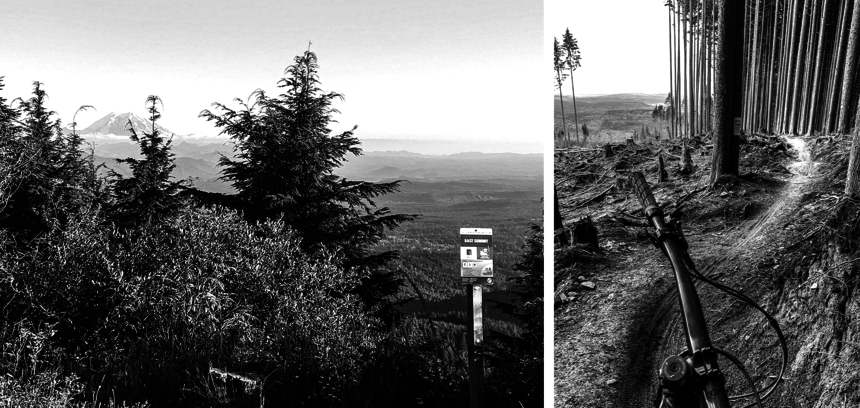
The icy heights of Mount Rainier (Tahoma) keep a watchful eye over the trails lower down. | Max Ritter photos.
While these options might be enough to satiate even the hungriest of riders, Evergreen is of course working on more, including a new black diamond tech line and a new blue flow trail off the back. These will hopefully be open to the public soon after Evergreen and DNR address some issues with local Tribal leaders who issued a moratorium on new trails after illegal trail building exploded on native lands in the area during the COVID-19 pandemic.
Raging River State Forest
Speaking of unsanctioned trail building, just up the road from Tiger lies yet another massive trail network that serves as an excellent example of how existing networks can become “legitimized” and fully supported for public use. Just outside North Bend, off I-90’s Exit 27, Raging River State Forest and its now nearly 30 miles of singletrack is the place to go for long adventure rides with some truly exceptional downhill runs. Set up as a series of stacked loops that drop off a two-way blue flow trail (that’s incredibly fun to ride in both directions), the network has slowly incorporated new trails into its area that were originally built by pirate trailbuilders. If you’ve ever heard of the Exit 27 freeride trails, they’re tucked into a hidden area of the woods just next to the named and mapped trails like No Service, Invictus, Canyon Creek DH, and Physical Therapy (PT). The first time I rode PT a few years ago, it was still unmarked and dropped into a maze of logging roads. Now, after a little bit of maintenance by Evergreen and an extension at the bottom, it connects beautifully into the larger network and can be ridden as part of a massive 21-mile, nearly 5000 vertical foot loop that will challenge your fitness and reward you with some of the best descents in the state.
Mike Westra, Evergreen’s Director of Trails, tells me about Evergreen’s approach to pirate trails: “Illegal building exploded during COVID, but for us it’s a pretty simple solution. Build the trails people want to ride, and the community will self-police and not go do their own thing illegally.” Evergreen has even gone so far as to engage the rogue builders and have them come out and build Evergreen-led projects. It’s a small community, after all. That doesn’t mean you should go build your own janky pirate trail in the hopes the Evergreen will hire you - the USFS and private landowners will not be stoked.
In terms of the process of legitimization, it’s really about patience. “So many trails started out as social trails and eventually got adopted as hiking trails. It’s difficult to get legitimate adoption for mountain bike trails. The way we look at it here, we look at a landscape, develop a system with the community and land manager, and figure out if we can agree whether a pirate trail should be legitimized. For example, PT fell right into place at the Raging River area,” says Westra. Years of working out the system has taught him one lesson: “You have to find the fox, the person who will push it through and is psyched on the program.”
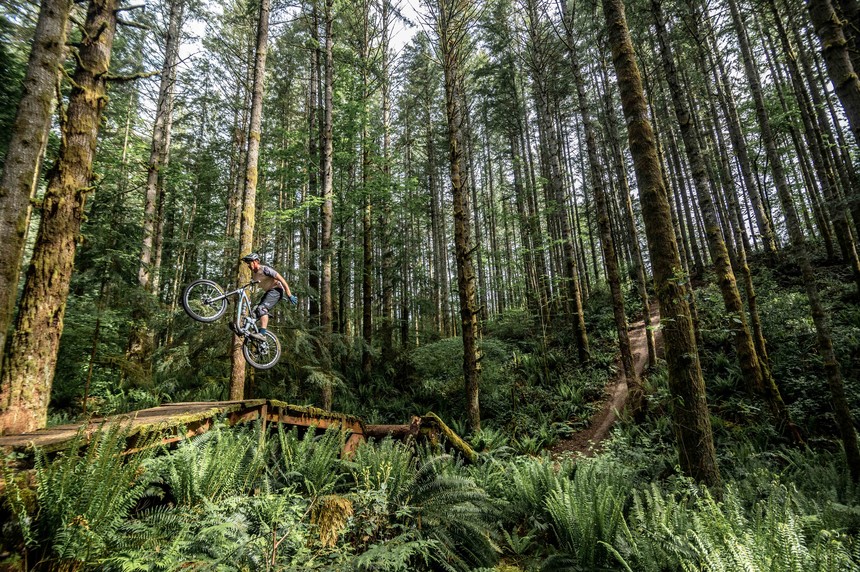
It's not just about rocks and roots in the woods here, there's plenty of opportunity for air time as well. Trevor Ford hits a classic. | Max Ritter photo.
At Exit 27, Westra shares a story about finding that fox. For the most part, the unsanctioned trails are built on US Forest Service land, so are publicly accessible, and the USFS certainly knows about them. A few years back, Evergreen took the USFS out to scope the lines and ask what to do about the illegally built trails. Of course, the trailbuilders came prepared, and brought along Scott Pettit, a 40-year-old chiropractor who was the original builder of the gnarliest jump line in the area. Pettit gave the rangers a demo of riding his jumps, and they were simply amazed that a middle-aged doctor was the one riding and maintaining it. “It opened their eyes to the possibility of legit freeride trails,” says Westra.
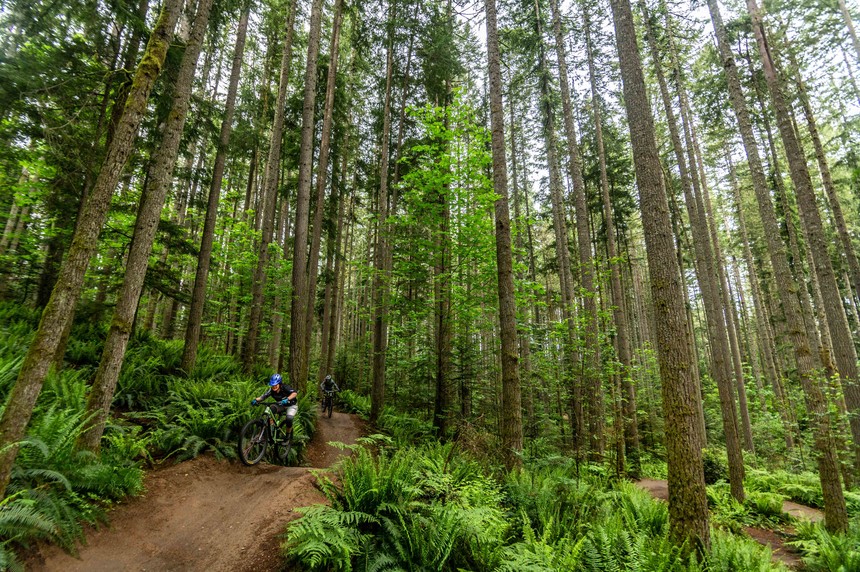
Zipping in and out of the lush green rainforest never gets old for locals Jessica Hatch and Allie Arvizu. | Max Ritter photo.
Those “legit freeride trails” have taken shape at Tiger and Raging, which are now the place to go for vert-hungry riders who are willing to put in the work on the uphill for massive rewards on the down. Raging’s No Service trail is a never ending disco of tech and flow on the way down, and really feels like you are way out there, hence the name. Bring extra snacks and more water than you think you’ll need. Climb back up Return Policy before embarking on a second screaming descent down the fast tech of Canyon Creek DH – which might be my favorite trail in the state. If you’re still not ready to be done, climb back up Raging Tiger to Raging Ridge, descend Upper and Lower PT for a taste of loamy, rooty PNW steeps, then head back up one last time to the top of Poppin’ Tops and Flow State for a fast and floaty ride back to the parking lot. If a massive ride isn’t what you’re looking for, any of these trails make for an unforgettable outing on their own. It’s remarkable how fun these trails can be for riders of a variety of skill levels – there’s really no speed limit on any of them, but the trails are just as fun to ride slower and progress your skills on. With plenty of easy regroup spots, they’re especially well-suited to ride with a larger group where not everyone is riding the same speed.
The Future
Of course, there’s always more. Outside of expanding and revamping their existing trails, Evergreen’s vision is to create a way to connect all the networks in the greater Seattle area via their “Evergreenway.” The vision, shared with the Washington DNR, is to connect Snoqualmie Pass (soon to be home of a lift-access bike park at the ski area) to Olallie, through Raging and Tiger, all the way to Duthie Hill and neighboring Soaring Eagle Park. This network of trails would be an unprecedented connection of some of the best downhill, cross-country, and enduro trails in the country, and would in theory allow riders to ride from the top of Snoqualmie Pass all the way to the Seattle suburbs on singletrack.
Every time I come back to this part of Washington, I’m amazed at what’s new. Knowing what Evergreen has its eye on for the future, I know that I will most certainly be coming back – and will always make sure to have my bike in tow, ready to drop in.
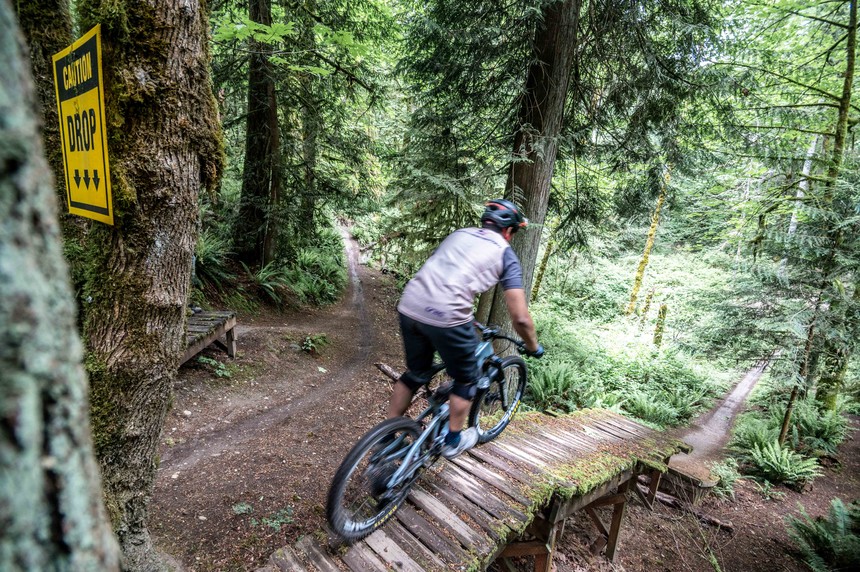
3...2...1...dropping! Trails are alive and well! | Max Ritter photo.
Support mountain biking in Seattle here.
Read more from the Blood, Sweat, and Gears series on TGR here.
